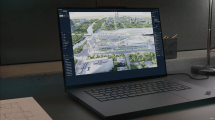You have to look at it completely without emotion and interest, but in the end many building blocks combine to form a very conspicuous and above all rather unattractive picture. I wouldn't go so far as to use the word piety as if it were about the dying or even the dead, but schadenfreude would also be completely out of place. At least when it comes to rewriting and rewriting the state of an entire industry, which often pretends to be doing well. But it doesn't.
Greed eats brains.
Three words could actually completely define what is currently the reason for the general gnashing of teeth. Wouldn't it be for the employees of the companies concerned who can't do anything about it. If you still know many of the faces from real life, then you almost suffer with it. Not with the executive floor, but with the rest underneath. But that's where Nvidia and the whole board partners sit in a plentiful licking boat and rowing together like wild.
A lot has already been written about mining, its boom and the foreseeable bursting of the bubble, but I would like to introduce a few things behind the story into the discussion today that many people do not even know. That's why I'm pushing Nvidia, as a chip supplier, a little bit at the end of this friday's speech and putting together what I've been thrown into many conversations with board partners and suppliers. The AIC is mostly doing badly, really bad.

Overstock
I have to break down the following somewhat in my understanding, even if the gentlemen BWLer will probably kill me for it. But mining back and forth, no production goes without the so-called forecast, i.e. a forecast. If you plan a certain amount of cards, then you also have to work with suppliers and wholesalers or component manufacturers. You can't go shopping on such orders of day, that wouldn't be possible (availability), would be too expensive or depend on coincidences. So the hamster factor comes into play, where you buy what's cheap on the market, accumulate what's left, and secure the cheapest options when it comes to longer-term orders.
But components also cost money first and extensive warehousing also wants to be well thought out and thought-out. Because everything ages and has to leave at some point. Such purchases always cost money and also tie up decent capital. Graphics cards are sometimes produced with borrowed money, even that is not for lau.
Product changes like to Turing can then have it in themselves and if you e.g. When you look at Nvidia's internal base design kit for the large RTX 28xx cards, you'll now focus on power stages, not single MOSFETs, MOSFET DCR (Direct Current Resistance) and not Inductive DCR. Apart from the fact that this is clearly expensive, there is suddenly a bottleneck here and there at good power stages. What has been good enough for Kepler, Maxwell and Pascal is no longer enough.
What do you do as a board partner with what is still rumbling around in the camp? It is installed on the simpler cards, even if the components are oversized and too expensive. The main thing is getting out of it. Which would have made me get back to mining and greed and closing the circle quite elegantly. After all, what the hell is a mining card?
For example, Yesterday I had a longer chat with a producer of such cards who currently don't know where to go with the GTX-1060 and GTX-1070-based cards. Apart from the fact that it is mainly only the already fully assembled boards in the warehouse, these could never be distributed as conventional graphics cards anyway. Because there are no essential things for the video output and the quality is so questionable that any RMA department would refuse with horror. Dead capital that no one needs.
Many of these cards also run outside Nvidia's Green Light program, so they would never get a proofed end-user BIOS. And if you know Nvidia's control frenzy, you'll understand that most of these semi-cooked mining products are already in free flight to the dump. Because even for rendering, they are virtually unsuitable. Rest in Peace.
Overcapacity
Take another board partner who not only bought a new factory in China (Mainland), but also doubled production capacity with all the force and a lot of money almost overnight because of the mining madness. During the peak hours, there were approx. 200K cards per week from the bands, whole 4K of them with AMD chips. This in itself shows the extreme imbalance in the balance into which the company voluntarily went. If production now collapses to half (which would still be very optimistic), then half of the production will be stopped.
In China, of course, the contracts with the assembly line ants can be solved more easily, especially since many receive only annual contracts (from CNY to CNY), but equipment and real estate still exist. Almost all of it is only rented, leased or (intermediately) financed and thus still costs a lot of money. Costs that must now be covered from the current business and which generally have to make this manufacturer's products more expensive, because nothing can be done in these companies without a mixed calculation.
By the way, this is not an isolated example and has already led some smaller players to the brink of business abandonment (some of them have probably been insolvent for a long time). If you want to buy an AIC, you can try it at the moment. Provided the necessary play money for a potential total loss.

Margins
Across board partners, one complains about the very low margins with which one can hardly compensate for the accrued and ongoing losses. Independently of each other, one speaks of less than 10% margin, which I can see as the difference between the net proceeds to the distribution and the total costs (material costs, manufacturing material, manufacturing wages, all special individual and overhead costs, social costs, all types of administrative costs, interest on debt including interest on provisioning, depreciation, research costs, calculative costs, distribution costs, RMA, reserves, etc.) has described. Some people only talk about 5% of the smaller Turing models (GeForce GTX), which remain with the manufacturer.
However, this should not be related to the current pharmacy prices in the retail trade, because here more is usually earned than with the board partner itself. Especially since at this point Nvidia comes back into play, which mercilessly passes on the development costs for Turing to the chip buyers. This criticism has to be, because many board partners would be really happy about former margins of 60% Nvidia to 40% AIC of a GTX 1080 Ti today. But such things are history.
Thus, not only AMD board partners have a real problem due to the lack of innovative new chips, but also those of Nvidia. And that's in addition to mining nonsense. I wouldn't want to write that Nvidia got up with Turing, on the contrary. But pushing something quite innovative then with force and without perfect preparation almost improvised into the consumer market, that has something brutally animalistic. Eat or die? But you can also suffocate gallantly while eating… That's just on the sidelines.
There are two reasons why the Radeon RX 580 and 590 are now becoming so cheap. First, Polaris is already so sucked out that you can't lose on these chips, but you can still earn well. The development costs have long since been incurred and you can almost play with the price. It is precisely this game that will probably hit the GeForce GTX 1660, which is due to be released this month and whose EIA will be used with approx. 229 to 239 USD. Thus the card would not be completely overpriced, but for the board partners almost the coffin nail. Because one thing must not be forgotten – it is the product category with potentially the highest sales figures and slumps in street prices.

Bottom line
And who is to blame? Good question, but greed and greed are even vicious companions. The mining bubble has burst, cloud rendering hasn't really started, and the Quadro RTX can also be used to instill areas where you could otherwise sell significantly more "traditional" graphics cards without RTX doping. In the end, everyone can really grab their noses, right down to the hobby-mining end customer. So to cut the chip manufacturers or board partners into the twelve on a flat-rate basis would not be quite as honest.
It's a chain of misjudgments by chipmakers, mismanagement decisions by board partners, insane market jumps, and technical uncertainties that have bent it all as skewed as it stands. That is why the question of price, in the truest sense of the word, is more complex than one might think as an end customer.
Nevertheless, I wish everyone a nice weekend 🙂
































Kommentieren